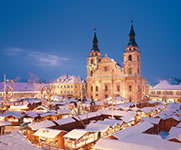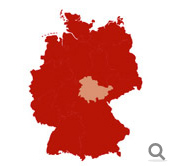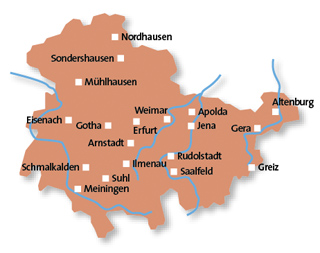
Historical Towns
- Historical towns in Brandenburg
- Cathedral Towns and Cities in Saxony-Anhalt
- The innovative Anhalt-Wittenberg Region
- Enchanting towns in the Harz
- The beautiful towns and cities in Saxony
- Towns and cities of culture in Thuringia
- Beautiful towns of Franconia
- East Bavarian traditional towns
- Alpine towns in the Allg�u
- The eastern Akpine Foothills and their towns
- Towns and villages in the western foothills of the Alps
- Mediterranean towns on Lake Constance
- Towns in the Swabian Alb
- Unspoilt towns in the Black Forest
- Towns for refined tastes in the Heilbronner Land
- Towns in the Odenwald
- Wine towns in Rheinhessen
- Saarland, a region of contrasts
- Romantic towns in the Hunsr�ck and Nahe Regions
- Idyllic towns and villages in the Moselle Region
- The Ahr Rhine Eifel holiday region
- Wine towns on the Romantic Rhine
- Modern towns and cities in the Bergisches Land Region
- The Lahn Valley and its fairytale towns
- Historical towns in Kurhessisches Bergland
- Sauerland's scenic towns
- Fairytale towns in the Weserbergland Hills
- Majestic towns in the M�nsterland Region
- The nine stars of Lower Saxony
- North and East Frisian Islands
- Vibrant Schleswig-Holstein
- Maritime towns along Mecklenburg's Baltic Coast
- Historical Hanseatic Towns
- Germany's Baltic Sea Islands
- The Mecklenburg Lakes
Contact and information
Verein Städtetourismus in Thüringen e.V.
c/o Erfurt Tourismus & Marketing GmbH
www.thueringer-staedte.de
c/o Erfurt Tourismus & Marketing GmbH
www.thueringer-staedte.de
Poets and philosophers culture in the heart of Germany

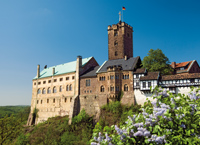
Eisenach
"The area is simply magnificent" said Goethe, describing the countryside around Eisenach. For centuries, history has been written here at Wartburg Castle, the seat of the Thuringian Landgraves. Elisabeth of Thuringia, who became a saint and a symbol of charity for her unwavering selflessness, lived at the residence high above Eisenach. Wartburg Castle was also where Martin Luther, under the alias Squire George, translated the New Testament into German 300 years later. Wagner based his Tannhäuser opera there, and the composer Bach was born in Eisenach. Wartburg Castle and the houses where Bach and Martin Luther were born are all authentic historical settings where you can immerse yourself in German history.Nature in all its glory the Thuringian Forest
The Werra river meanders gently through the Eichsfeld region whose castles sit in splendour atop craggy peaks. The autumn sun bathes the beech forests of the Rhön hills and Hainich nature park in a deep red. Every now and then you see the Thuringian Slate Mountains in the east, whose wooded peaks, reservoirs and rugged valleys invite comparison with Switzerland. All of these features make the Thuringian Forest such an attractive destination. The Rennsteig area, with Oberhof as its focal point, is a popular region for winter sports in central Germany. Prominent among its attractions is the Rennsteig itself, a 168km trail which for centuries brought merchants, travellers and walkers to Thuringia.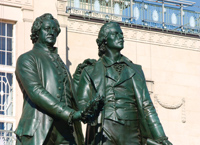
Classical Thuringia
The major towns in Thuringia are linked over a distance of 300 kilometres: more than 1,260 years of history have given Erfurt, the regional capital, a towering cathedral, the unique Merchants' Bridge, an Augustinian abbey, Petersberg Citadel and the oldest synagogue in central Europe. Luther, Napoleon, Bach and Goethe are just some of the prominent figures whose legacy endures to this day. Gotha is renowned for its important collections in Friedenstein Palace and the historical Ekhof Theatre, which still stages plays in summer. Jena is an innovative centre of technology that continues to be popular with the science and arts community. Attractions include the world's oldest working planetarium and the beautiful limestone hills on the SaaleHorizontale trail. The ducal seat of Weimar has a great history and an even greater cultural significance that belies its modest size. Lucas Cranach, Herder, Wieland, Liszt and the poets Goethe and Schiller are among its former residents, joined in later centuries by Harry Kessler and Henry van de Velde pioneers of modern art and also Walter Gropius and his Bauhaus colleagues. Goethe's House and Schiller's House get most attention, but there's barely a house in Weimar which has not been occupied for at least a few years by some distinguished individual or other. A large part of the town, including all the marvellous parks and gardens, has been designated a UNESCO World Heritage site.Schmalkalden
Sunny Schmalkalden is a former Landgraves' seat on the south-western slopes of the Thuringian Forest. In 1530, the town was at the forefront of European politics when Protestant powers joined forces as the Schmalkaldic League in defence against Charles V, the Holy Roman Emperor. Nine tenths of the houses in its listed centre are of medieval origin, and the Renaissance splendour of Wilhelmsburg Palace is almost entirely preserved. All of which makes this pretty little town the most magnificent of Thuringia's royal seats. The Rennsteig, the old Thuringian hills route, runs right past Schmalkalden, whose welcoming inns and well-appointed hotels are ideally located for activities in the Thuringian Forest.Hearty Thuringian fare
A warm welcome and delicious food await wherever you go in Thuringia. The region's disparate territorial roots and its location at the crossroads of major historical trading routes have made it a land of great diversity with a wealth of customs and traditions. Rustic dishes dominate the regional cuisine. Dumplings and bratwurst sausages are staples but there are many other local specialities: marinated pork steak and pork spit-roasted over birchwood, schmandkuchen and zwiebelkuchen, sausages of all description and the traditional St. Martin's Day goose. A dark Köstritzer beer makes the perfect accompaniment, followed by a Neudietendorfer Aromatique a herbal liqueur that has been used for centuries to aid digestion.Travel Planner
Select an option...
Romance and charm
Discover a scaled-down world of splendour at the Rococo en miniature exhibition in Rudolstadt, where ten palaces, some 1,000 figures and 1,000 items of furniture were lovingly created in minute detail in the space of 50 years.
Food and drink
Word is spreading fast about Thuringian specialities. There is so much to discover, from Mühlhausen plum purée and doppelkorn distilled in Nordhausen to Greiz's Fürstengold pilsner.
History and tradition
The remarkable Gera Caves offer an insight into the history of brewing in the town. They were dug out as beer cellars in the 17th and 18th centuries. Ten caves are open to the public as part of guided tours.
Nature and scenery
When the light goes out and all you can hear is your heartbeat amid the silence, you'll know you've arrived at Saalfeld Fairy Grottoes. Guided tours of the world's most colourful show caves are accompanied by a magnificent spectacle of light and music.




